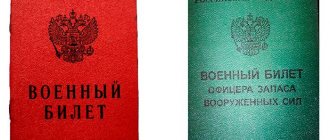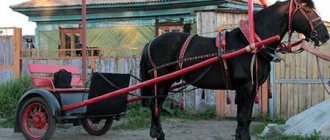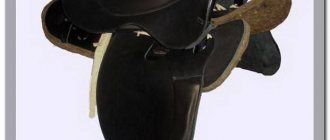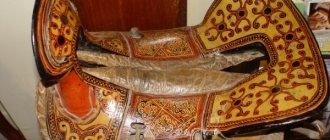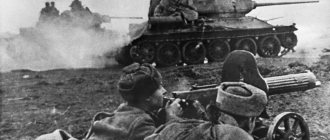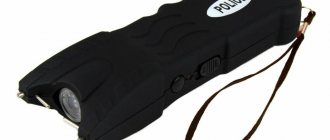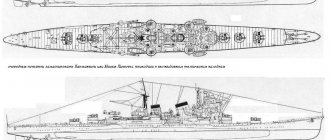This article will talk about decorating horse harness, or as it is popularly called by instrument search enthusiasts, “horse meat.” Let's look at popular types of horse meat and give signs that can be used to roughly date the found find. At the end of the article there are interesting photos of crafts that can be done with found horse meat. I hope this article will help ensure that in the future there are no incidents like the one in the photo below.
Decorating horse harness began from the moment it appeared. Most likely, at first, it had a functional use for tightening straps and separating straps in a harness. Later it developed into decoration. Moreover, evil spirits do not sleep, the horse needs to be protected somehow, so they hung the horse with bright sparkling plaques and ringing bells. They were made of brass, copper and bronze, some could be gilded.
Types of harness
All options are divided into 3 groups according to scope of use:
- Agricultural.
- Traveling.
- Transport.
The harness is also divided into 3 groups according to the number of harnessed horses:
- Singles.
- Pairs. These harnesses are used to equip sleds.
- Multi-horse. Also used in sledding.
The following types of harness are considered the most popular:
- One-horse Russian. It is often called European harness.
- Line-by-line-drawbar. In such a harness you can use either one or two horses.
- Line by line. It is very easy to use, but is considered not good enough, since it does not protect the horse’s health. For traffic safety when using such a harness, it is recommended to equip the cart with a brake.
- Tachanochnaya. This is a very complex horse harnessing system. At one time it was very popular, but today it is not used at all.
- Combined team. This harness design came to us from Europe. It can be used with both lines and shafts.
The simplest in use and design are considered to be single-horse Russian and line harnesses.
Russian single-horse or arc
The main difference between this horse harness and others is the presence of an arch. It is made in the old-fashioned way from a single piece of wood. With its help, tugs hold the shafts.
In the old days there were specialists who made arcs. The fact is that making them was not easy: it was necessary to select and process them correctly in order to obtain a strong, elastic and lightweight element of the harness.
Russian single-horse harness consists of the following elements:
- Arc. It was described above.
- Clamp. One of the main elements of single-horse harness. It ensures the transfer of traction from the horse to the cart. Clamps come in different sizes. The length of this element is measured from the inner cushion at the top to the pincers. The width is measured between the tug holes. The clamp consists of such elements as: pliers, pillows, tugs, clamps, tire, supon, gort and lining. The clamp must be adjusted in size to a specific horse. After adjustment, it should fit snugly to the top of the animal’s withers, rest on the crest of the neck and press well against the shoulders. On the sides of the horse's body, the collar should rest on the muscles of the shoulder blades.
- Harness. This element covers the horse's body. Its task is to support the clamp during braking.
- Saddle. It is located slightly below the withers. It is entrusted with the task of absorbing shock loads on the animal’s back during movement. The saddle is adjusted to the size of the horse's withers.
- Cross-dealer. This element of the harness is located next to the saddle and holds the structure of the clamp, arc and shaft. In addition, it distributes weight evenly throughout the structure.
- Podbelly. Allows you to avoid sudden jerks of the collar and shaft when the horse is trotting or galloping.
- Bridle. As a rule, a snaffle model is used.
- Rein. This is an elongated version of the bridle. Used to control a horse from a carriage. The reins are attached to the bits. Previously, this element was made of leather. Now it is made from thick tarpaulin.
Line-by-line or arcless harness
Its main difference from the Russian single-horse harness is the absence of an arc. That is, the traction force is transmitted directly through the clamp. The latter is attached to the cart with straps.
The design of such a horse harness consists of:
- A clamp with horse-drawn eyelets to which the lines are attached.
- The lines themselves.
- Saddles.
- Girths.
- Interchangeable.
- Gorts replacing tugs
- Bridles.
- Reins.
The European version of this harness differs in that it does not have a collar. A curtain is used instead. This is a durable leather bib with rings, to which lines are attached using metal carabiners. The reins are passed through the neck rings and a special clamp on the saddles.
In the Russian and European versions of the line-by-line harness, the most important role is given to the harness. It is she who is entrusted with the task of uniformly distributing pressure throughout the horse’s body.
When the horse is properly equipped, the harness extends 5 cm below the ischial tuberosities. If it is raised above this level, it will constantly ride up and rub the animal’s rump. If it is lowered below the specified level, it will interfere with the horse's progress.
The length of the harness is chosen so that a palm can be placed between its side strap and the horse’s hips.
As for the thickness of the bib in the European version of the line harness, it should be at least 2.5 cm.
What does the harness consist of?
The main element of horse harness when riding is the saddle. The harness may also include the following accessories:
- Clamp. This is the most important item in the system. Used to evenly distribute the weight of the cart on the shoulders and neck of the animal. The size and shape of the element are selected individually. It is located on the neck near the withers and passes through the base of the neck.
- The arc is necessary for fastening the tugs to the shafts.
- The bridle is placed on the horse's head and allows you to control the animal. There are bridle options with one or more bits. The option without a bit is called a halter. Used when moving a horse without harness.
- The saddle is a structural part. This is a leather shock-absorbing cushion. Allows you to reduce the load on the horse's shoulders. Passes under the saddle belt. Necessary to support the shaft.
- Harness. Consists of longitudinal and transverse, as well as slope belts. Used to prevent the clamp from slipping.
- Horse reins are long straps that are highly durable. The edges of the reins are attached to the bits. This element allows you to remotely control the animal.
- Intersaddler. It looks like a belt attached to the shaft through a saddle.
- The girth is necessary for a strong fixation of the saddle. This is a wide belt of high strength.
- The tugs hold the rim belt, connecting the clamp to the shafts.
- The underbelly prevents injury to the horse and absorbs sudden vibrations of the collar and shaft.
- The dowel is a sliding rein that does not allow the animal to raise its head high.
- The martingale is part of the harness that holds the horse's head in the desired position.
- A blanket is a special blanket whose purpose is to protect the animal from bad weather and insects.
A saddle pad, which is a special blanket, is placed under the saddle. Boots are also used - equipment to protect the animal’s legs from mechanical damage.
Types of horse equipment
The above elements can be added or removed. It all depends on what type of harness you need to put on the horse. In general, the team is divided into 3 large groups depending on what functions the horse will perform. These can be transport, travel or agricultural types of harness, which, in turn, are divided into several categories:
- Single-horse, which is put on a horse with or without a bow. Applies to one horse only. An arc harness will consist of a bow, a collar, a horse-drawn harness and other elements of the harness, while an arcless harness will be distinguished by the absence of an arc.
- The line-drawbar part of the harness is needed to regulate the movements of the horse and control the cart. The main emphasis is on the drawbar, which is located on the side, the harness attaches it to the horse’s head, and the tension belt helps connect the drawbar to the collar.
- Line-by-line is rarely used due to the fact that it is inconvenient for horses of different types. The entire traction force falls on the lines and the clamp, and it becomes inconvenient to control the reins.
- A combined one is needed in cases where you need to put 6 to 8 horses in a team. This type of harness is chosen based on the height and strength of the horses. The strongest are placed in front, and the rest are placed at the back of the column. The rider must not only be able to drive a cart, but also be a skilled horseman, since improperly tensioned reins or commands can carry such a carriage in an unknown direction.
The cart harness is not used now. It consisted of a drawbar and lines that were put on 4 horses. The cart team was once accompanied by a train, which was intended to allow the draft horses to move in single file. They put a train on six horses, and then they could very slowly carry the cart and rider.
Any part of the harness must fit the horse exactly so as not to injure the animal.
How to choose quality equipment for a horse
The harness is constantly in contact with the animal's skin, so it is very important that it creates a minimum of discomfort for him. It is usually made from leather (bovine or calf), which allows it to be durable and elastic.
Let's start choosing ammunition with a bridle. For trotters, and other breeds, it is most often made from rawhide, which allows it to stretch well but not tear. Bridles have a size guide. By design, they are “blown” (an additional strip of leather or elastic is sewn on the forehead and on the applied belt, trimmed with leather of a different color to make it look nice) and “round” (made of double stitched leather). There is no need to pay special attention to this moment; it is rather decorative in nature. The main thing is that the leather is of high quality, has a manufacturer’s “stamp”, a label, even seams, and all elements are sewn evenly.
The same must be taken into account when choosing other components of the harness, such as a rein and a girth. When choosing a reason, you need to remember that they come in leather, rubber and braid. The former are durable only if the top is not glossy, but the latter are difficult to choose high-quality ones, since there is often no solid leather insert under the rubber top. If you are lucky enough to choose the original, they will be very convenient. Braid ones, especially imported ones, are easy to maintain and last longer than the two previous options.
Important! Each rider chooses the width of the reins independently, but it is not advisable to take it wider than 2 cm, since it is not convenient to hold them, and the strength of the material is enough so that a narrower strip of rein does not break.
Girths can be made of natural and artificial leather, synthetic materials: the main thing is that this element of ammunition is durable, but at the same time elastic. This is necessary so that it secures the saddle well on the horse’s back and at the same time does not interfere with the horse’s sides rising and falling when breathing.
The type of saddle depends on what goals you set for yourself. It is better not to take a universal or multifunctional one, since each type of riding should have its own saddle. For example, if you plan to ride for a long time, then a Western (cowboy) saddle with additional softening inserts is best suited. A horse can stay in an English saddle for no longer than 2–3 hours. Also, the saddle must be individual for each horse, since the back structure of animals varies.
When choosing tensiles and stirrups, give preference to metal, as it is a more durable material compared to plastic and rubber. Stirrups are selected individually for each rider. Choose a stirrup width that is 20–25 mm larger than the width of your shoes, since your foot should fit in and out of the loop freely. It’s good if the stirrups have a rubber insert that will prevent your leg from slipping.
Types of harness
The harness is divided into different types according to the number of harnessed horses (from 1 to
- single-horse;
- cart;
- line-and-drawbar;
- line-by-line;
- combined;
- zug.
Let's take a closer look at each of the listed types of horse harnesses. Learn how to weave a halter for a horse with your own hands.
Single-horse
This type of harness is divided into arcless and arc. The archless version does not have a collar; instead, a harness is used that transfers the load from the cart to the horse. This type of equipment includes shafts and belts: bridle, reins, throats. Otherwise, such a system is called a shaft-line system, and, often, shorter shafts are used here and are attached to the saddle located on the horse’s back.
The bow harness is a classic European one, proven over the centuries - a collar, a bow, horse-drawn belts, shafts, saddles, reins, a bridle. In this case, the shafts are attached to the arc.
Tachanochnaya
An outdated type of harness, which was used when harnessing horses to move a cart (cart). In this version of the harness, the system consisted of lines that were put on 4 animals and a common drawbar. It would be a mistake to think that this type of harness made it possible to develop greater speed. It could have been considered relatively large at the beginning of the last century, and even then, everything depended on the load of the transported cart.
This harness is a variant of the line-drawbar harness, when 2 more horses are attached to the sides by lines to 2 animals fastened to the drawbar.
Did you know? The secret of the speed (up to 60 km/h) of the “Russian Troika” lies in the help of 2 native horses. Korennik galloped at a trot, and the trailing ones galloped at a gait with their heads curved to the side, so all crew members were less tired.
Line-by-line-drawbar
In this version, the drawbar is rigidly attached to the shafts, which is a universal option for harnessing both 1 and 2 horses. With the help of a harness, the drawbar is fixed near the horse's head, and a fastened belt secures it to the collar. With this type of fastening, all movements of the horse are strictly consistent with the subsequent movements of the cart.
This type of harness when using a two-wheeled cart can injure the pet, since the load of the drawbar on the collar is too large. You can reduce the pressure by using a saddle and tightening the straps using a saddle strap.
Line by line
From the name it is clear that there are no shafts in such a harness, and the animal is controlled using a belt traction. This type of control is very inconvenient and requires a lot of physical strength, since it is very difficult to hold the cart and control it even at low speed - the horse’s temper and inertia can lead to undesirable consequences.
Read more about such important parts of equipment as stirrups and saddle pads.
Also, without the support of shaft control, the cart constantly tries to run over the horse and gets under its feet with the threat of injury. With this method of harnessing, the cart must have a means of braking, which is not always possible to implement.
Combined
This type of harness is used in cases where it is necessary to harness many horses - 6-8. When placing animals, a tactic is used in which larger and stronger individuals are placed in front, and smaller horses are located behind them. Combined harness involves the use of a system consisting of a drawbar, lines, and a shaft.
Separately, it is worth mentioning the features of managing such a crew. It is necessary to select horses for him very carefully. Strong and calm animals at the head of the “column” will reliably hold the cart, even if the weaker ones walking behind begin to lose their pace.
The combined harness involves 3 types of horses:
- indigenous - holding the direction and stability of the crew;
- fastened - fastened with strings in a pair or three to the main ones and are responsible for the correct movement during a turn;
- external ones are the main labor force, they are placed ahead of the main ones and pull the entire system in a given direction.
Did you know? In Rus', harnesses were painted with both pagan and Christian symbols - from paintings protecting against evil forces and wild animals, to signs meaning various saints.
Zug
The train harness is not used in our time due to its archaic nature. Exceptions include historical shows, pleasure carriages, and filming of film episodes. The system was made up of 6–8 horses, which were harnessed one after another, singly or in pairs. This method was invented in Germany and is close to the line-drawbar method: the indigenous individuals are harnessed in 1-2 pairs, and all the rest are fastened with outriggers.
Due to the nature of the train harness, the string of horses moved the cart very slowly. Therefore, over time, the train was abandoned in favor of faster sleds.
What is a harness
Horse harness is a set of various items that is necessary when controlling horses. Used for saddling and harnessing horses. All devices included in the harness are put on the horse’s body. Animal owners consider harnesses an important attribute of horse riding. The components of such equipment are carefully selected, taking into account the physique of the horse and its dimensions.
Correct selection and fitting of horse harness will ensure uniform distribution of pressure when transferring the draft force of the horse to the cart. Harness elements must be selected taking into account the conditions of use of the horse. The modern definition of what horse harness is includes all kinds of equipment.
Types of harness
Known types of horse harnesses are divided into 3 types:
- away;
- transport;
- for work in rural areas.
They consist of several subspecies.
Single-horse
The design for one individual can be arcless or arced; one animal is equipped with it. The arc version consists of arcs, a clamp, tugs, etc.
With the arcless method, the entire weight of the sleigh or cart falls on the harness. Single-horse structures are equipped with collars and a yoke with special horse-drawn lobes.
Line-by-line-drawbar
This type of horse equipment is used on one or a pair of horses. Its main purpose is to control the movement of the cart/sleigh and smooth entry into turns.
The main element of the equipment is the drawbar located on the side. If a pair of stallions is harnessed, the drawbar is fixed in the middle. The drawbar is placed on the head using a special harness or connected to a clamp.
Line by line
The line-by-line design is quite simple to implement, but inconvenient to use in practice. While the horse and equipment are moving, sometimes it is not possible to restrain the sleigh or cart.
The traction comes from the lines and the yoke. Experienced breeders recommend equipping the trailing harness with brakes - this will help avoid injury to the cattle.
Tachanochnaya
Today, the cart type of harness is not used in practice.
It was relevant in the period before the 1900s. The equipment consists of lines and a drawbar; up to 4 fillies are harnessed to it. Today it is almost impossible to find something like this.
Combined
This device is designed to unite a large number of horses - 6-8 individuals. You can select them ideally if you know the draft force and height of the animal.
The column is always headed by the most resilient and strong horses, which set the direction. To drive the cart in the right direction, the rider must skillfully lead the horses.
TsUG is a German invention and is used on 6 animals at the same time. Along with the cart harness, the TsUG is almost never used in practice at the present time.
Animals are harnessed to such a structure in pairs or in single file.
Cleaning and storage
- Fabric products are periodically washed and dried.
- After each removal, the elements are wiped clean from dirt.
- After riding in precipitationy weather, the harness is wiped dry.
- Metal elements should be washed and thoroughly rubbed to make them shine.
- Hard-to-reach areas of the saddle are treated with a foam sponge, and the main surface is cleaned with cream soap and then wiped. The saddle should be disassembled before drying.
- Frequent exposure to water causes leather elements to become hard and wrinkles form on them. It is enough to do wet cleaning once a week.
- Bridles are cleaned regularly. You can wash the belts in a container with soapy water and then wipe them dry.
- Girths, bandages and boots are cleaned with a brush after drying.
- After removing the saddle, the saddle pad must be dried. To do this, it is turned over.
Proper maintenance and storage of your harness will extend its life.
DIY making
If you are interested in how to make a cart with your own hands, you must first read the instructions, prepare the appropriate tools and materials, and complete diagrams and drawings. Only after this can you make a horse cart with your own hands. The algorithm of actions is as follows:
- First you need to complete the chassis of the entire structure. The chassis consists of a welded solid frame and axles for the wheels. You can carry out welding yourself, but if you do not have the necessary experience and skills, then it is best to entrust this work to a specialist. The axles and frame can be made from a profile: then they will be solid. Another option is pipes with thick walls.
- Now you need to make a stationary axis, which will be located at the rear. Then make the one that will be in front. It should turn on the pin (2 washers should be fixed).
- Before you finish the axle that will be located in the front, you need to decide on the type of cart. If it is a drawbar, then you will have to additionally make a special clamp for the drawbar. The shafts must be welded to the front axle, and a special clamp will also be needed. In other words, the shafts will not be removed, but they must be positioned movably so that, due to the holder, they can be directed to the sides, up, down. By the way, they can be fixed on a bracket. For reinforcement, cords are used - these are wire rods. Their diameter should be approximately 1 cm. The wire rod should be fixed to the front axle and shaft.
- The chassis needs to be completed by installing the wheels. If necessary, they also install brakes.
- Now you need to make the body to your taste. You can simply cut the boards and make a platform that will be attached to the frame. This option can be modified.
- Shafts can be made from metal pipes. Wooden beams are also suitable.
- You can make a seat in the back.
Horse carts are the oldest means of transport. Gradually they were improved and modified, so that new designs appeared (for example, carriages). The harnessing process also gradually became more complicated.
The history of the appearance of the harness
According to historical data, people began to use horse harnesses around the 2nd millennium BC. At least this is evidenced by elements of harness found in ancient burials. However, many researchers are inclined to assume that ancient people began to use harnesses even earlier.
In ancient times, horse owners paid great attention not only to the quality of the harness, but also to its appearance. The fact is that by the artistic design of this horse equipment one could determine the social status of the owner
The fashion for beautiful harnesses began in the Middle Ages. At that time, the angle was set to functionality. Horses began to be used mainly for transporting heavy loads. It never occurred to anyone to just ride these animals.
Around the middle of the 16th century, horse harnesses began to be made beautiful and of high quality again. It is explained by the fact that carriages and open horse-drawn carriages came into use among people.
Unfortunately, today horse harness has completely lost its meaning. Technology has completely replaced horses from human economic activity. They are used in sports competitions and entertainment.
Antique horse jewelry is a frequent treasure hunter's find.
Those who have recently begun to engage in instrumental search very often face the problem of identifying and correctly evaluating finds. Each brass plate or piece of copper utensils seems to be a treasure of unprecedented price, but in reality everything is much simpler.
In fields and villages over many decades, countless objects have fallen into the ground, from lost coins to rusty nails. Many antiques were made of non-ferrous metals - brass, copper, bronze. All of them emit a very clean and pleasant signal on a metal detector, often similar to a coin signal, for this reason we dig up a huge mass of all kinds of pieces of iron during the season. Most of them are not of any interest, due to the lack of at least some value, but they are sometimes very interesting.
Elements of decoration of horse harnesses can be attributed to this category of finds. They come across a great variety of different shapes and types, which diggers call in one word - horse meat.
The number of harness elements can reach more than a dozen varieties. On some forums you can even find special sections dedicated to this topic. There they determine whether this item really was once a decoration for the horse and what part of the harness it was in.
Let's look at the horse jewelry that comes up most often during a search with MD.
Interchangers
Quite a common find in the fields. It is a bracket with a base.
1
The product itself is attached to the saddle; belts are passed through its rings to hold the shafts, which are called saddle holders. This is where the name of this part of the harness came from. Although the correct term is to call them pads or saddle clamps. It should be noted that they are not identical in appearance and have a number of varieties.
2
Plaques
Round figured plates. They were attached to the harness for beauty, and also served as belt separators.
3
Large plaques, as a rule, were bronze; medium-sized plaques were made of brass, less often copper.
4
Rings
4
They served to connect and separate belts, as well as fasten some other elements of the horse’s equipment.
Decorations
5
Any horse harness could not do without them, be it the workhorse of a peasant, cavalryman or landowner. The differences were only in the sophistication of execution and the beauty of forms. Although it must be said that stately horses from wealthy families of the noble classes often sported silver-plated or even gilded elements of the harness.
The most common simple decorations include strips, buttons (circles), pucolas, squares, rosettes, and polka dot buttons.
Some of the beautiful ones include burrs, foreheads, flat and oval pendants, and doodles.
Bells
Of course, the most attractive are bells. The main (large) one was suspended in the center on an arc - this is the so-called subarc bell, next to it there were sometimes a row of smaller ones - backing bells, and even further along the arc there were bells.
Finding any of them safe and sound is a great success; usually their fragile walls cannot withstand the consequences of many years of cultivation of the land.
These are the constant attributes of horse harness
In addition to these items, from time to time you come across dividers (covers), buckles, clickers, drawbar bows and a number of other things that are directly related to the harness. If possible, their photographs will also be posted in the future.
Most of the elements of harness decoration have no value whatsoever, with the exception of bells and bells. The rest are of some interest only to connoisseurs. Yes, don’t be surprised there are diggers who collect the most beautiful and well-preserved such finds. After cleaning them, they create very beautiful panels from them.
Selecting a team based on the number of horses
One team can have several horses at once. Depending on the number of horses, the teams have their own names. For example, two individuals harnessed behind each other are called a tandem. If horses walk next to each other, they form a pair.
A couple can have such horse harnesses as mixed and drawbar. If an individual needs to harness an agricultural device, then a trailing harness is used. Due to its high traction resistance, it eliminates the possibility of the gun rolling over and accidentally injuring the horse.
The three-horse team also includes different forms. The most popular is the Russian troika, which has a root in the middle and fastenings on the sides. There was another type of triplets - harnessing horses in single file, during which the rootman was behind the tethered individuals. Three-piece single file is best used for winter roads.
If there are four individuals, then you can create a team of two forms. In the first case, you need to place the horses in pairs one after another (outrigger and drawbar). This is a more classic quad. In the second case, the horse is in one line: the drawbars on the sides frame a pair of roots in a drawbar pair. This type of harness is called a cart or quadriga.
On the territory of Russia, the drawbar and Russian shaft-type harness are considered more common. At the same time, the shaft appeared earlier, but is now almost never used. Drawbar harnesses are still used in our country to this day. It appeared in the 17th century and spread among us as a result of the Polish-Lithuanian invasion.
Another type of harness of individuals is the five-piece. It is created by a pair of root players and three extensions in a line. Six horses are placed in a train of three pairs. A larger number of heads in a harness (seven or more) are not suitable for use on the farm. These types of harnesses are most often used at ceremonial processions or entertainment parades.
Today you can find a large number of types of harnesses and ways of placing a horse in them. With all this, if there are about six horses in one team, then such teams are used in household work. A large number of individuals in a harness most likely serve a decorative function rather than a useful one.
Horses are currently widely used in equestrian sports and competitions. There are even competitions that test the skill of handling harnesses. A correctly worn harness helps not only increase the productivity of an individual, but also maintain its health and strength.
Equipment for the rider
Equipment for riders comes in several options: amateur, classic, sports.
Did you know? In the 18th century, fox hunting became popular in Britain.
While chasing prey, it was not convenient to hold on to the old saddle designed for heavy knights, so the British began to seriously lighten this element of equipment and were able to create a copy weighing 500 g. This is how the classic English saddle appeared. For amateur horse riding, you can wear:
- jeans;
- shirt;
- vest;
- comfortable shoes without fasteners or other decorations, with a small square heel;
- helmet
The elements of classic equipment are:
- breeches (leggings);
- riding boots or boots and hags;
- shirt with hunting tie;
- Redington jacket;
- helmet;
- gloves;
- whip.
Sports equipment:
- breeches;
- shirt;
- tie;
- gloves (white);
- helmet (black);
- boots (black);
- Redington jacket (red, blue, black, green), in dressage it is replaced by a tailcoat.
Equipment for a horse is very important both for itself and for humans. The health of the animal, as well as the safety of him and the rider, will depend on the correctness of its selection. Accordingly, although some of its elements can be made independently, it is better to purchase them ready-made in special stores, especially if you have never encountered making harnesses.
Clamp structure
The standard option includes:
- lining;
- mites;
- clamp.
The shafts in the harness need more tugs, and the cart with lines needs tugs. The size of the clamp depends on the pincers, which exactly follow the shape of the horse's neck. These parameters must be constantly monitored: if the horse is exhausted or, on the contrary, gains weight, the harness must be changed.
Clamp structure
The length of the clamp is defined as the distance between the highest and lowest points. A short model can put pressure on the neck and interfere with normal breathing, while a long model hangs too low and makes movement difficult.
The material for ticks can be maple or birch. The fibers should be located along their length. Today there are plywood pliers on sale. This budget option does not like dampness, so it must be protected from moisture.
Ticks
At the bottom of the pliers, the connection is disassembled, this allows you to easily put on the clamp and adjust the size on the neck. The wood from which the clamp is made cuts into the skin and puts pressure on the muscles, so they use a clamp in the form of a leather case stuffed with straw or felt.
The filler is stuffed tightly into a leather case 1-2 mm thick. The clamp and pliers are connected with nails so that the lining protrudes by 5 cm. The tugs are attached on the outer side between the lower border of the pliers and 1/3 of their length. Shafts are then secured in these belts made of pigskin or calfskin, 9-12 cm wide. Modern materials include rubber and artificial analogues. In addition to fastening functions, tugs also play the role of a shock absorber.
In the photo, the pliers are covered with a felt clamp
The saddle is a complementary element that transfers the load of the compressive clamp from the neck to the back. For a standard hull, a humpback saddle is usually used. For special body configurations, standing and flat varieties are suitable.
Main types of harness
There are several classification groups of equestrian equipment. So, depending on the scope of use, harnesses are divided into agricultural (for field work), traveling (for equestrian sports) and transport (for carts). In addition, the division is carried out according to the number of horses in teams, which can be single, paired and multi-horse (from three to 6-8 animals).
Horse racing team
Classification is also made according to the method of harnessing, because this determines which elements of the harness will or will not be used. In this case, seven groups are distinguished.
- Single-horse arc - only one animal is harnessed to the cart, using a wooden arc and full horse-drawn clothing.
- Shaft-line - in this case, all the elements of the previous version are present, except for the arc. The leading role of the horse-drawn part is played by the harness. The shafts have a shortened size and are attached not to the clamp, but to the saddle.
- Line-drawbar - the main element is the drawbar, with the help of which the turning movements of the cart are regulated. In this manner you can harness either one or two horses.
- Line-by-line - the most simplified version without an arc and a shaft. The structure is fixed using a clamp and straps. This type of harness is often equipped with a hand brake, because otherwise it is difficult to stop an over-speeding horse.
- Tachanochnaya is an outdated type of harness designed for 4 animals. Two of them in the middle are harnessed with a drawbar, and the side horses are harnessed with lines.
- Combined type - used for a large number of horses: 6-8. The equipment includes a drawbar, lines and shafts.
- Tail - used for six horses. The native animals are harnessed to the drawbar, and the outriggers are fastened with lines.
Six-horse combination team
We, city dwellers, are increasingly moving away from wildlife, communicating less and less not only with wild animals, but also with domestic animals, including horses. However, if in the urban economy the role of the horse is reduced to a minimum, then in villages the importance of the horse has even increased in recent years. The horse easily adapts to work in various conditions, which allows it to be a “universal engine”, and in some cases even more economical than a mechanical engine.
The main characteristics of the working qualities of horses are: traction force, speed of movement, duration of work. The best horses for working in the countryside are those that have a live weight of 400...600 kg and have good walking speed. Horses of trotting, draft, and riding breeds, as well as medium-sized heavy draft horses, have such qualities.
In summer, on a dirt road, a horse weighing 400...500 kg, harnessed to a cart, carries up to 500 kg of cargo, and in winter, on a sleigh on a well-worn road - up to 700 kg.
Rice. 1. Harness of the Russian arc harness: 1 – intersaddler; 2 – shaft; 3 – supon; 4 – bridle; 5 – arc; 6 – clamp; 7 – saddle; 8 – harness; 9 – reins
The most important element of a horse’s equipment is the harness, which must withstand the maximum effort of the horse and be precisely adjusted to the horse so as not to cause damage to it when moving. There are several types of harnesses: for single-horse, double-horse, three-horse and multi-horse harnesses (harnesses). Among the harnesses there are usually distinguished: arc, arcless and drawbar. In Fig. Figure 1 shows a diagram of an arc harness. The main elements of the harness for such a harness are:
a bridle used to control a horse;
a saddle, the purpose of which is to soften and correctly distribute the pressure of the saddle on part of the muscles of the withers and back of the horse;
a saddle bar, which, passing through the saddle, supports the shafts and arc, transfers part of the traction force to the horse’s back;
a harness covering the horse's body holds the collar on the shoulders during mounting and descending, transferring the pressure of the cart to the horse's croup;
a collar necessary to transfer forces from the harness to the horse's shoulder;
the reins with which a horse is controlled.
Rice. 2. Drawbar-drawn carriage
The use of a bow and shaft allows the horses to be symmetrically positioned in harnesses and the traction force to be evenly distributed among them. The use of a drawbar harness (Fig. 2), common in Europe, did not allow achieving high speeds, while Russian carriages drawn by a troika were the fastest means of transportation and enjoyed worldwide fame. This system is still known today as the “Russian Troika”.
Rice. 3. Combat saddle
For horseback riding, horses are fitted with saddles. Three types of riding saddles are common: combat, Cossack and sports. The action saddle (Fig. 3) is comfortable for the horse and rider when traveling long distances. When traveling over very rough terrain, a Cossack saddle is good, which is additionally equipped with a pad and underrest, which keeps the saddle from slipping on steep ascents and descents. A sports saddle is the lightest.
Rice. 4. Horse ride
On farms, carts are used to transport people and goods. The basic element of all carts is horse travel. In Fig. 4 shows a horse-drawn carriage, which is suitable for transporting logs, pipes and various long objects. The load is placed on the travel pads between the handles, the weight of the horse travel is 170...190 kg. To transport bulk cargo, such as hay, straw, the horse tread is raised and lattice walls - pellets - are installed on it (Fig. 5).
Rice. 5. Cart - grains
Of course, the most universal and widespread cart is the cart - a one-horse shelf (Fig. 6). The weight of the cart is 250...270 kg, the track width is about 1 m, the load capacity is 750 kg. The wheels of the cart are standard - the diameter of the front is 720 mm, the rear - 900 mm.
Rice. 6. Single shelf
A springless cart (Fig. 7), which has a removable box body, is used for transporting bulk cargo; such a cart is often called a best-pack.
Rice. 7. Cart
A four-wheeled carriage - tarantas (Fig. 8.) is harnessed to one or two horses.
Rice. 8. Tarantas
In Fig. Figure 9 shows a light carriage on two wheels - a gig. Its load capacity is up to 200 kg, the body is suspended on springs.
Rice. 9. Gig
Even now in villages there are carts (horse-mounted tankers) for transporting fuels and lubricants to equipment working in the fields (Fig. 10). A 200-liter barrel equipped with a hand pump and hoses is installed on the cart. Under the seat, in a box, cans of lubricants are installed.
Rice. 10. Horse-mounted fuel tanker
The St. Petersburg Hermitage displays the carriage of Peter I (Fig. 11). The stroller is characteristic of its time in its technical data and artistic design. The body suspension in the stroller was carried out using wide, thick belts that replaced springs.
Rice. 11. Carriage of Peter I (1704)
In Russia, where the winter period lasts up to 6 months, sleighs occupy a special place. For what purpose were sledge sledges not used (Fig. 12). They carried cargo, brides to church, and the owner on his last journey. The sledge beds were braided with rope or covered with planks. Sleighs were made with undercuts (bound runners) and without undercuts. The load capacity of such sleds is up to 1000 kg, the weight of the shackled sled is 140...150 kg, the track width is 520...720 mm.
Rice. 12. Sleigh sledge
A light sleigh with a shaped body (Fig. 13) was used to transport 2...3 riders, either as a one-horse team or as a three-horse team. On a well-trodden road, such a sleigh, drawn by three horses, reached speeds of up to 40 km/h.
Rice. 13. Light sleigh with shaped body
Another winter carriage - the sleigh of Empress Elizabeth Petrovna - is presented in the Hermitage exhibition (Fig. 14). The sleigh is made from valuable wood, decorated with expensive fabrics, gilding, carvings, and painting.
Rice. 14. Ceremonial sleigh of Elizabeth Petrovna (1760)
It is now difficult for a city dweller to see a horse harnessed to a sleigh or cart, and when you are lucky enough to meet this eternal helper of man, people involuntarily stop to look at the miracle given to us by nature.
Protective equipment
To ensure that the animal feels comfortable at any time of the year and is not exposed to hypothermia, special ammunition was developed. In addition to protecting against weather conditions, it is used to prevent injuries and sprains.
blanket
A universal invention that gives the animal a feeling of warmth and dryness. It is actively used during the transportation of horses; in the stable it saves from sudden temperature changes. It is mainly made from warming wool fabric. It is fixed on the body of the horse using fasteners.
At its core, a blanket is a special protective blanket that is used for heating. Since constant grooming and regular washing reduce the horse's protective fat layer, it needs additional protection. Any type of blanket is produced taking into account the climate and physiological characteristics of the horse. The variety of these bedspreads is comparable to the number of dresses in a fashionista’s closet. It is recommended to purchase several types of blankets for all occasions. The emphasis should be on three basic varieties: a winter version, a deo modification for sweat absorption, and a “home” version for stables.
Levadnaya. This variety is used in situations where it is necessary to provide the horse with dry conditions. Made from compacted synthetic material that prevents the penetration of air and moisture. On the other hand, this fabric, thanks to its specially designed structure, allows moisture formed on the surface of the animal’s body to escape without creating conditions for overheating.
Levada blanket keeps the horse dry
Night. Made from reliable, durable fabrics with a specific lining. Recently, materials that do not require frequent washing are gaining popularity. In the autumn, it prevents the formation of undercoat, which the animal usually grows for the winter. This is a very important point, since overly thick hair makes caring for the animal quite problematic.
Night blankets prevent the formation of winter undercoat
New Zealand Levadna. Belongs to the group of heavy capes. It is made on the basis of tarpaulin, and received its name thanks to the country in which it was developed. Since it is quite heavy, special straps are used to secure it.
Wag and Gladiator. Made from synthetics. They are popular due to their specific cut: in addition to the body, they also protect the horse’s neck.
The Wag and Gladiator blanket protects the horse's neck
Konyushennaya. Designed for animals kept in stalls. Their main function is to protect horses' fur from dust and dirt.
Stable blanket protects the horse from dust
Melton. A cozy “cape” made of wool. It accumulates heat well, but due to this property it is quite heavy in weight, and cleaning it is quite problematic.
Wool blanket accumulates heat
In addition to these varieties, there are waterproof, special fly blankets, and there are even protective covers with holes for the eyes and ears.
Bandages
To protect horse limbs, cotton bandages are used to protect them from sprains. In the cold season, they are good as a warming agent.
During training, knitted or crepe bandages are used, about 8 cm wide. They must be wound very carefully on special linings
To ensure free blood flow, it is very important not to squeeze the limbs. You should also avoid any gaps where dirt can get in.
Bandages prevent horse limbs from sprains
Saddle pad
Its second name is a saddle cloth, which is a bedding under the saddle that protects the horse’s back from namin.
A saddle pad (saddle pad) protects the horse’s back from namins
